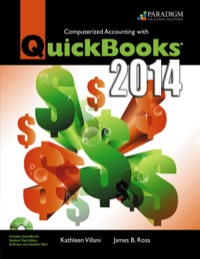Question
Please use the provided template to solve the question and please show work / formula of working cell for a thumb up. Please use the
Please use the provided template to solve the question and please show work / formula of working cell for a thumb up.
Please use the provided template to solve the question and please show work / formula of working cell for a thumb up.
Please use the provided template to solve the question and please show work / formula of working cell for a thumb up.
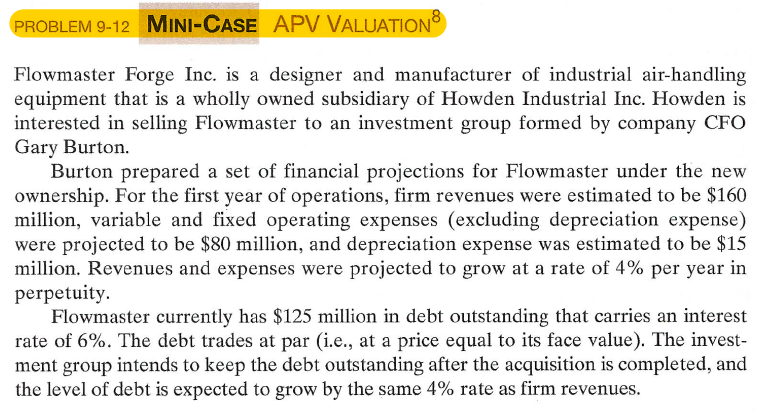
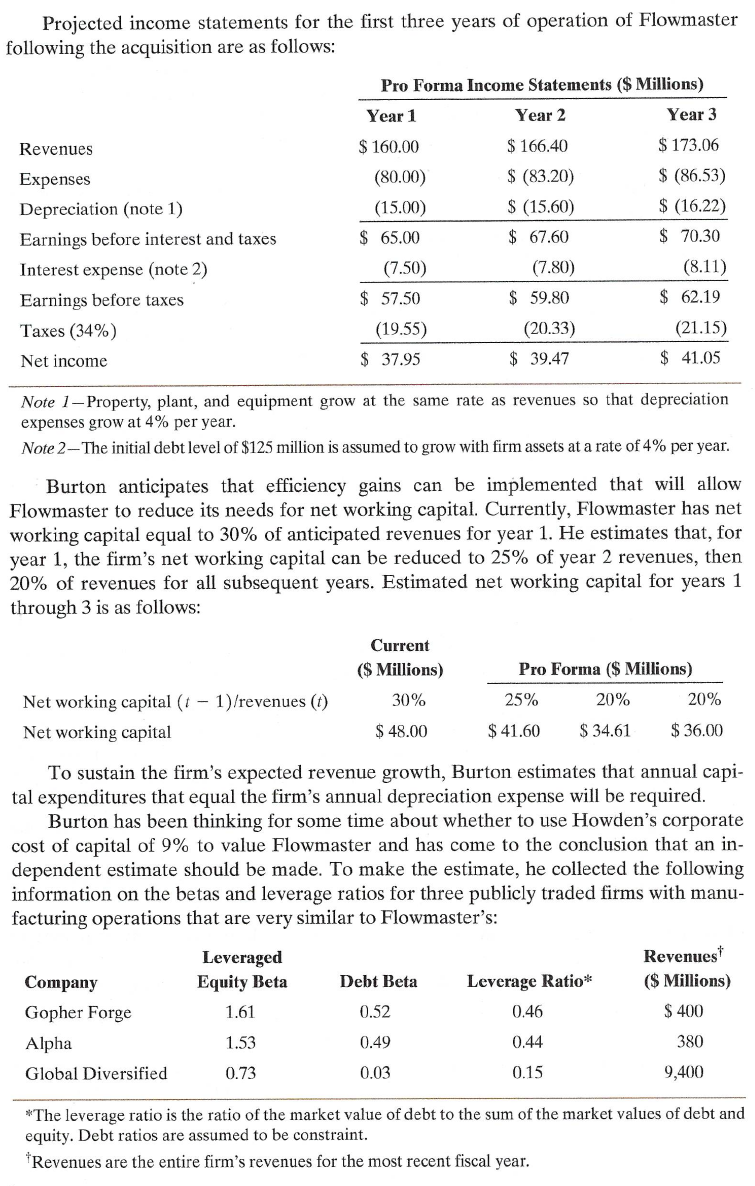
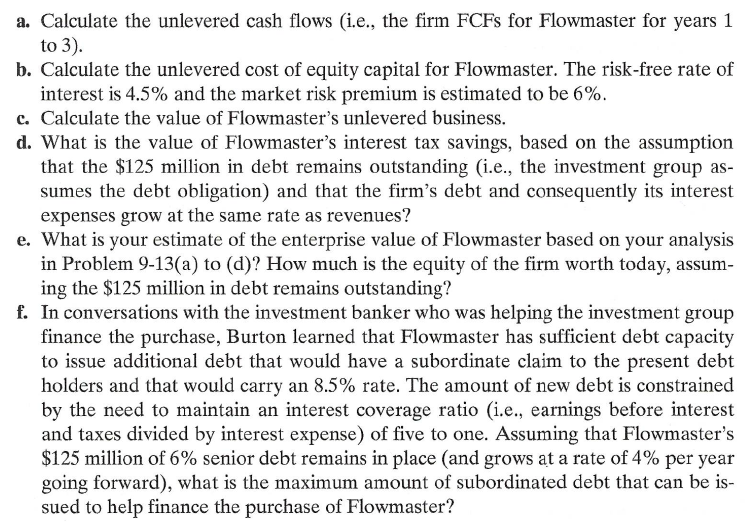
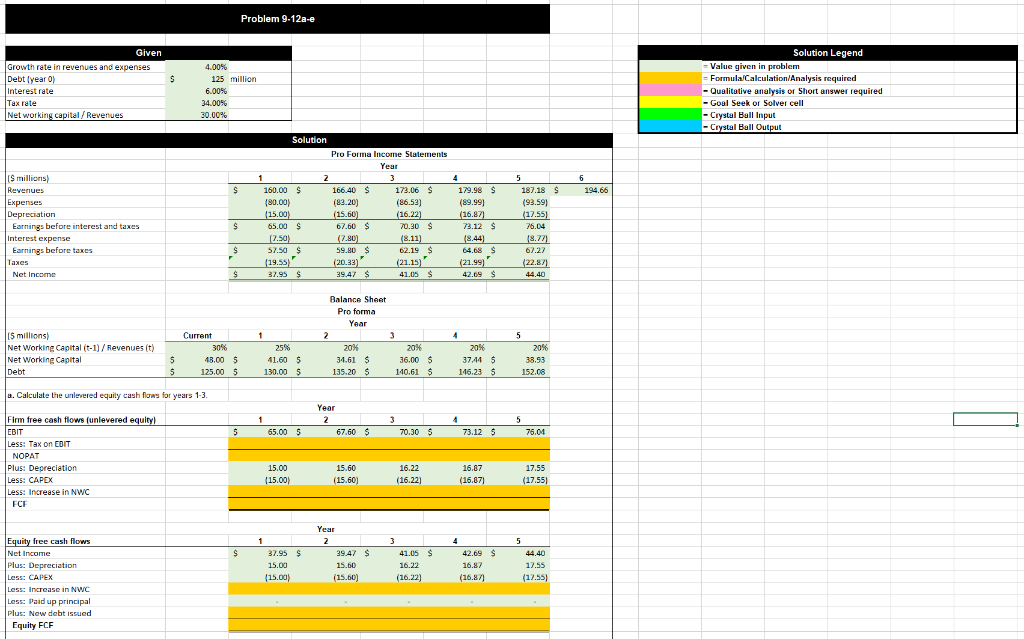
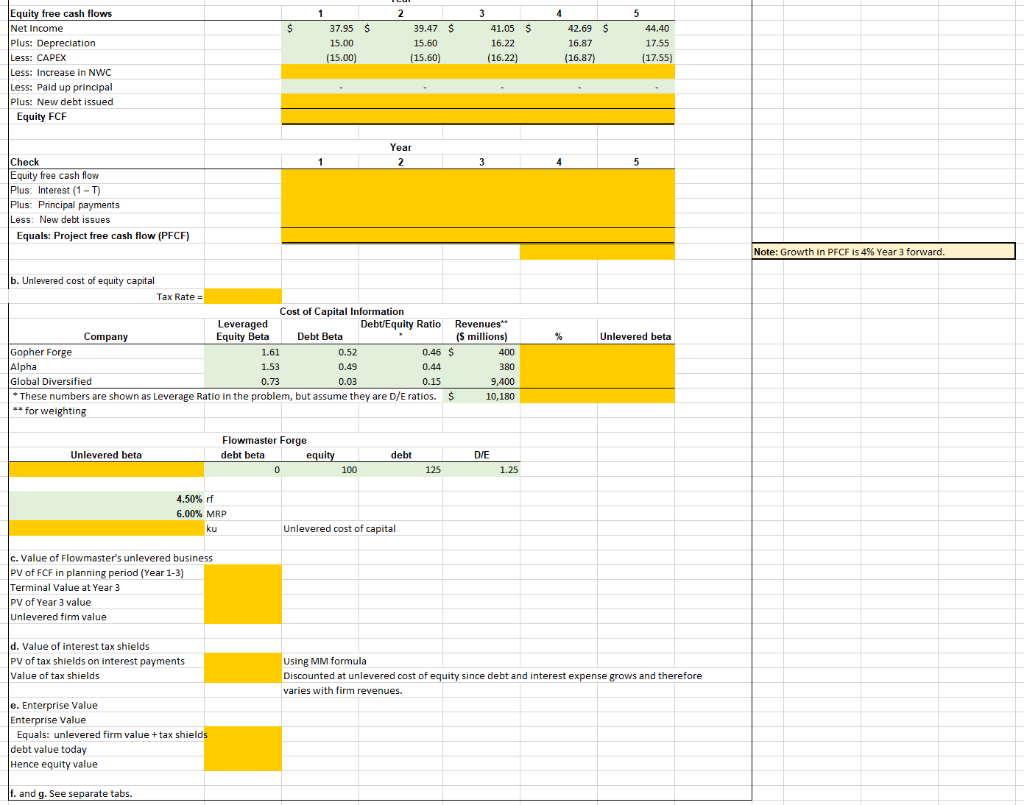
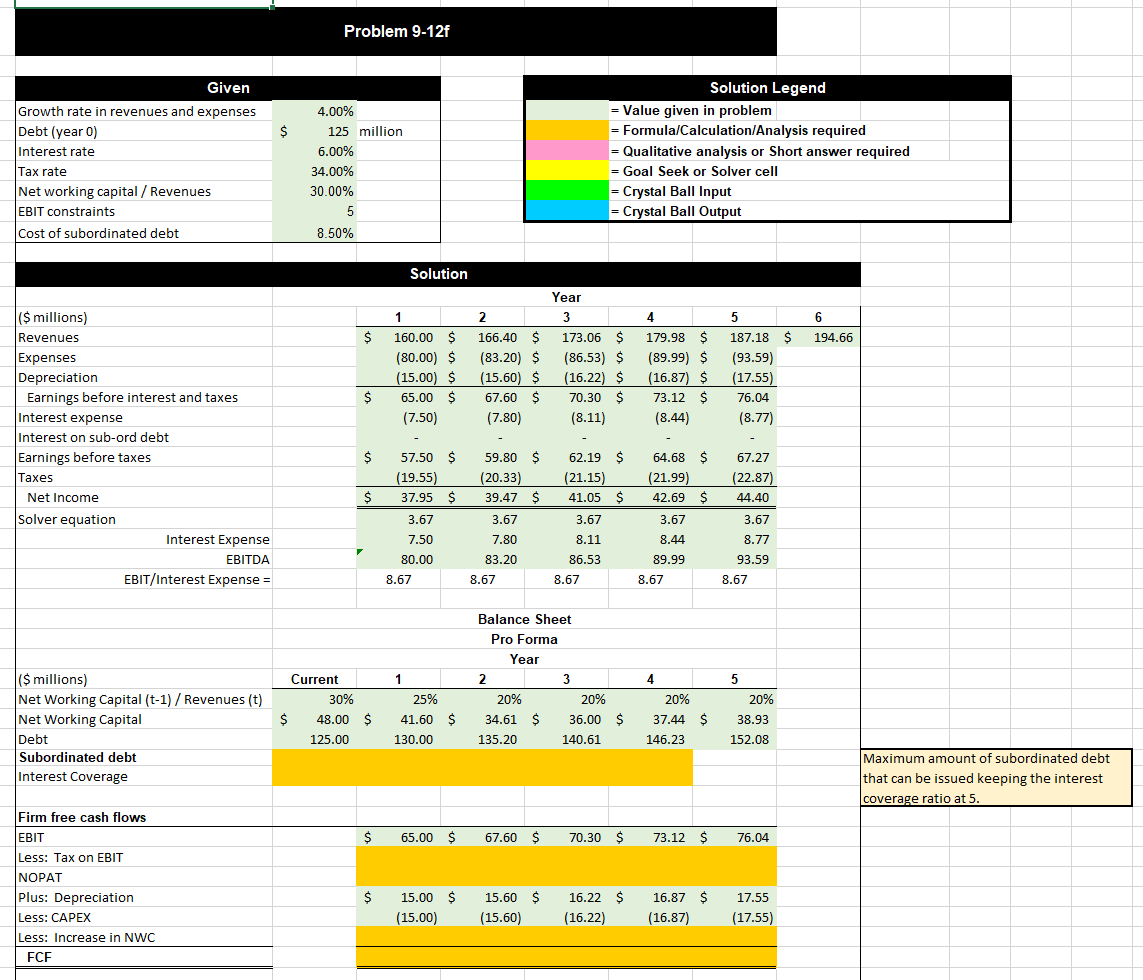
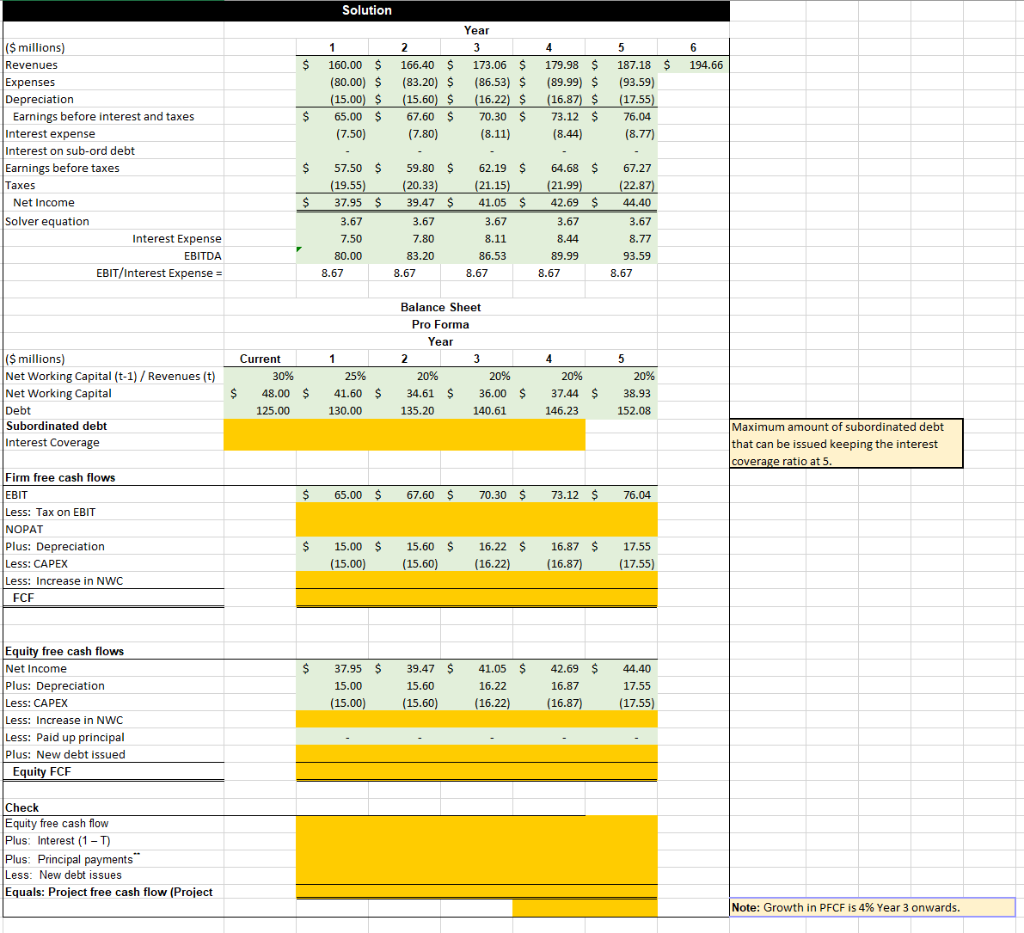
Please use the provided template to solve the question and please show work / formula of working cell for a thumb up.
Please use the provided template to solve the question and please show work / formula of working cell for a thumb up.
Please use the provided template to solve the question and please show work / formula of working cell for a thumb up.
PROBLEM 9-12 MINI-CASE APV VALUATIONS Flowmaster Forge Inc. is a designer and manufacturer of industrial air-handling equipment that is a wholly owned subsidiary of Howden Industrial Inc. Howden is interested in selling Flowmaster to an investment group formed by company CFO Gary Burton. Burton prepared a set of financial projections for Flowmaster under the new ownership. For the first year of operations, firm revenues were estimated to be $160 million, variable and fixed operating expenses (excluding depreciation expense) were projected to be $80 million, and depreciation expense was estimated to be $15 million. Revenues and expenses were projected to grow at a rate of 4% per year in perpetuity. Flowmaster currently has $125 million in debt outstanding that carries an interest rate of 6%. The debt trades at par (i.e., at a price equal to its face value). The invest- ment group intends to keep the debt outstanding after the acquisition is completed, and the level of debt is expected to grow by the same 4% rate as firm revenues. Projected income statements for the first three years of operation of Flowmaster following the acquisition are as follows: Revenues Expenses Depreciation (note 1) Earnings before interest and taxes Interest expense (note 2) Earnings before taxes Taxes (34%) Net income Pro Forma Income Statements ($ Millions) Year 1 Year 2 Year 3 $ 160.00 $ 166.40 $ 173.06 (80.00) $ (83.20) $ (86.53) (15.00) $ (15.60) $ (16.22) $ 65.00 $ 67.60 $ 70.30 (7.50) (7.80) (8.11) $ 57.50 $ 59.80 $ 62.19 (19.55) (20.33) (21.15) $ 37.95 $ 39.47 $ 41.05 Note 1 - Property, plant, and equipment grow at the same rate as revenues so that depreciation expenses grow at 4% per year. Note 2-The initial debt level of $125 million is assumed to grow with firm assets at a rate of 4% per year. Burton anticipates that efficiency gains can be implemented that will allow Flowmaster to reduce its needs for net working capital. Currently, Flowmaster has net working capital equal to 30% of anticipated revenues for year 1. He estimates that, for year 1, the firm's net working capital can be reduced to 25% of year 2 revenues, then 20% of revenues for all subsequent years. Estimated net working capital for years 1 through 3 is as follows: Current ($ Millions) 30% Pro Forma ($ Millions) 25% 20% 20% Net working capital (1 - 1)/revenues (t) Net working capital $ 48.00 $ 41.60 $ 34.61 $36.00 To sustain the firm's expected revenue growth, Burton estimates that annual capi- tal expenditures that equal the firm's annual depreciation expense will be required. Burton has been thinking for some time about whether to use Howden's corporate cost of capital of 9% to value Flowmaster and has come to the conclusion that an in- dependent estimate should be made. To make the estimate, he collected the following information on the betas and leverage ratios for three publicly traded firms with manu- facturing operations that are very similar to Flowmaster's: Leveraged Revenues Company Equity Beta Debt Beta Leverage Ratio* ($ Millions) Gopher Forge 1.61 0.52 0.46 $ 400 Alpha 1.53 0.49 0.44 380 Global Diversified 0.73 0.03 0.15 9,400 *The leverage ratio is the ratio of the market value of debt to the sum of the market values of debt and equity. Debt ratios are assumed to be constraint. Revenues are the entire firm's revenues for the most recent fiscal year. a. Calculate the unlevered cash flows (i.e., the firm FCFs for Flowmaster for years 1 to 3). b. Calculate the unlevered cost of equity capital for Flowmaster. The risk-free rate of interest is 4.5% and the market risk premium is estimated to be 6%. c. Calculate the value of Flowmaster's unlevered business. d. What is the value of Flowmaster's interest tax savings, based on the assumption that the $125 million in debt remains outstanding (i.e., the investment group as- sumes the debt obligation) and that the firm's debt and consequently its interest expenses grow at the same rate as revenues? e. What is your estimate of the enterprise value of Flowmaster based on your analysis in Problem 9-13(a) to (d)? How much is the equity of the firm worth today, assum- ing the $125 million in debt remains outstanding? f. In conversations with the investment banker who was helping the investment group finance the purchase, Burton learned that Flowmaster has sufficient debt capacity to issue additional debt that would have a subordinate claim to the present debt holders and that would carry an 8.5% rate. The amount of new debt is constrained by the need to maintain an interest coverage ratio (i.e., earnings before interest and taxes divided by interest expense) of five to one. Assuming that Flowmaster's $125 million of 6% senior debt remains in place (and grows at a rate of 4% per year going forward), what is the maximum amount of subordinated debt that can be is- sued to help finance the purchase of Flowmaster? 1 2 s 37.95 $ 15.00 (15.00) 39.47 $ 15.60 (15.60) 3 41.05 $ 16.22 (16.22) 4 42.69 $ 16.87 (16.87) 5 44.40 17.55 (17.55) Equity free cash flows Net Income Plus: Depreciation Less: CAPEX Less: Increase in NWC Less: Paid up principal Plus: New debt issued Equity FCF Year 2 3 5 Check Equity free cash flow Plus: Interest (1-T) Plus: Principal payments Less: New debt issues Equals: Project free cash flow (PFCF) Note: Growth in PFCF is 4% Year 3 forward. % Unlevered beta b. Unlevered cost of equity capital Tax Rate Cost of Capital Information Leveraged Debt/Equity Ratio Revenues Company Equity Beta Debt Beta (5 millions) Gopher Forge 1.61 0.52 0.46 $ 400 Alpha 1.53 0.49 0.44 380 Global Diversified 0.73 0.05 0.15 9.400 *These numbers are shown as Leverage Ratio in the problem, but assume they are D/E ratios. $ 10,180 ** for weighting Unlevered beta Flowmaster Forge debt beto equity 0 debt D/E 100 125 1.25 4.50% rf 6.00% MRP ku Unlevered cost of capital c. Value of Flowmaster's unlevered business PV of FCF in planning period (Year 1-3) Terminal Value at Year 3 PV of Year 3 value 3 Unlevered firm value d. Value of interest tax shields . PV of tax shields on interest payments Value of tax shields Using MM formula Discounted at unlevered cost of equity since debt and interest expense grows and therefore varies with firm revenues. e. Enterprise Value Enterprise Value Equals: unlevered firm value + tax shields debt value today Hence equity value f. and g. See separate tabs. . g. . Problem 9-12 $ Given Growth rate in revenues and expenses Debt (year 0) Interest rate Tax rate Net working capital / Revenues EBIT constraints Cost of subordinated debt 4.00% 125 million 6.00% 34.00% 30.00% 5 8.50% Solution Legend = Value given in problem = Formula/Calculation/Analysis required = Qualitative analysis or Short answer required = Goal Seek or Solver cell = Crystal Ball Input = Crystal Ball Output Solution 6 194.66 $ ($ millions) Revenues Expenses Depreciation Earnings before interest and taxes Interest expense Interest on sub-ord debt Earnings before taxes Taxes 1 160.00 $ (80.00) $ (15.00 $ 65.00 $ (7.50) 2 166.40 $ (83.20) $ (15.60) $ 67.60 $ (7.80) Year 3 173.06 $ (86.53) $ (16.22) $ 70.30 $ (8.11) 4 179.98 $ (89.99) $ (16.87) $ 73.12 $ (8.44) 5 187.18 $ (93.59) (17.55) 76.04 (8.77) $ - $ 67.27 59.80 $ (20.33) 39.47 $ 3.67 62.19 $ (21.15) 41.05 $ 3.67 (22.87) 44.40 57.50 $ (19.55) 37.95 $ 3.67 7.50 80.00 8.67 $ Net Income Solver equation 64.68 $ (21.99) 42.69 $ 3.67 8.44 89.99 7.80 Interest Expense EBITDA EBIT/Interest Expense = 3.67 8.77 93.59 8.11 86.53 8.67 83.20 8.67 8.67 8.67 4 5 ($ millions) Net Working Capital (t-1) / Revenues (t) Net Working Capital Debt Subordinated debt Interest Coverage Balance Sheet Pro Forma Year 2 3 3 20% 20% 34.61 $ 36.00 $ 135.20 140.61 20% Current 30% $ 48.00 $ 125.00 1 25% 41.60 $ 130.00 20% 37.44 $ 146.23 38.93 152.08 Maximum amount of subordinated debt that can be issued keeping the interest coverage ratio at 5. . $ 65.00 $ 67.60 $ 70.30 $ 73.12 $ 76.04 Firm free cash flows |EBIT Less: Tax on EBIT NOPAT Plus: Depreciation Less: CAPEX Less: Increase in NWC FCF $ 15.00 $ (15.00) 15.60 $ (15.60) 16.22 $ (16.22) 16.87 $ (16.87) 17.55 (17.55) Solution 6 $ 194.66 1 160.00 $ (80.00) $ (15.00) $ 65.00 $ (7.50) 2 2 166.40 $ (83.20) $ (15.60) $ 67.60 $ (7.80) Year 3 173.06 $ (86.53) $ (16.22) $ 70.30 $ (8.11) 4 179.98 $ (89.99) $ (16.87) $ 73.12 $ (8.44) 5 187.18 $ (93.59) (17.55) 76.04 (8.77) $ ($ millions) Revenues Expenses Depreciation Earnings before interest and taxes Interest expense Interest on sub-ord debt Earnings before taxes Taxes Net Income Solver equation Interest Expense EBITDA EBIT/Interest Expense = $ 59.80 $ (20.33) 39.47 $ 62.19 $ (21.15) 41.05 $ 64.68 $ (21.99) 42.69 $ $ 57.50 $ (19.55) 37.95 $ 3.67 7.50 80.00 8.67 3.67 8.44 3.67 7.80 83.20 8.67 3.67 8.11 86.53 8.67 67.27 (22.87) 44.40 3.67 8.77 93.59 8.67 89.99 8.67 4 li$ millions) Net Working Capital (t-1)/ Revenues (t) Net Working Capital Debt Subordinated debt Interest Coverage 20% Balance Sheet Pro Forma Year 2 3 20% 20% 34.61 $ 36.00 $ 135.20 140.61 Current 30% $ 48.00 $ 125.00 1 25% 41.60 $ 130.00 5 20% 38.93 152.08 37.44 $ 146.23 Maximum amount of subordinated debt that can be issued keeping the interest coverage ratio at 5. $ 65.00 $ 67.60 $ 70.30 $ 73.12 $ 76.04 Firm free cash flows |EBIT Less: Tax on EBIT NOPAT Plus: Depreciation Less: CAPEX Less: Increase in NWC FCF $ 15.60 $ 15.00 $ (15.00) 16.22 $ (16.22) 16.87 $ (16.87) 17.55 (17.55) (15.60) $ 37.95 $ 15.00 (15.00) 39.47 $ 15.60 (15.60) 41.05 $ 16.22 (16.22) 42.69 $ 16.87 (16.87) 44.40 17.55 (17.55) Equity free cash flows Net Income Plus: Depreciation Less: CAPEX Less: Increase in NWC Less: Paid up principal Plus: New debt issued Equity FCF Check Equity free cash flow Plus: Interest (1-T) Plus: Principal payments su Less: New debt issues Equals: Project free cash flow (Project Note: Growth in PFCF is 4% Year 3 onwards. PROBLEM 9-12 MINI-CASE APV VALUATIONS Flowmaster Forge Inc. is a designer and manufacturer of industrial air-handling equipment that is a wholly owned subsidiary of Howden Industrial Inc. Howden is interested in selling Flowmaster to an investment group formed by company CFO Gary Burton. Burton prepared a set of financial projections for Flowmaster under the new ownership. For the first year of operations, firm revenues were estimated to be $160 million, variable and fixed operating expenses (excluding depreciation expense) were projected to be $80 million, and depreciation expense was estimated to be $15 million. Revenues and expenses were projected to grow at a rate of 4% per year in perpetuity. Flowmaster currently has $125 million in debt outstanding that carries an interest rate of 6%. The debt trades at par (i.e., at a price equal to its face value). The invest- ment group intends to keep the debt outstanding after the acquisition is completed, and the level of debt is expected to grow by the same 4% rate as firm revenues. Projected income statements for the first three years of operation of Flowmaster following the acquisition are as follows: Revenues Expenses Depreciation (note 1) Earnings before interest and taxes Interest expense (note 2) Earnings before taxes Taxes (34%) Net income Pro Forma Income Statements ($ Millions) Year 1 Year 2 Year 3 $ 160.00 $ 166.40 $ 173.06 (80.00) $ (83.20) $ (86.53) (15.00) $ (15.60) $ (16.22) $ 65.00 $ 67.60 $ 70.30 (7.50) (7.80) (8.11) $ 57.50 $ 59.80 $ 62.19 (19.55) (20.33) (21.15) $ 37.95 $ 39.47 $ 41.05 Note 1 - Property, plant, and equipment grow at the same rate as revenues so that depreciation expenses grow at 4% per year. Note 2-The initial debt level of $125 million is assumed to grow with firm assets at a rate of 4% per year. Burton anticipates that efficiency gains can be implemented that will allow Flowmaster to reduce its needs for net working capital. Currently, Flowmaster has net working capital equal to 30% of anticipated revenues for year 1. He estimates that, for year 1, the firm's net working capital can be reduced to 25% of year 2 revenues, then 20% of revenues for all subsequent years. Estimated net working capital for years 1 through 3 is as follows: Current ($ Millions) 30% Pro Forma ($ Millions) 25% 20% 20% Net working capital (1 - 1)/revenues (t) Net working capital $ 48.00 $ 41.60 $ 34.61 $36.00 To sustain the firm's expected revenue growth, Burton estimates that annual capi- tal expenditures that equal the firm's annual depreciation expense will be required. Burton has been thinking for some time about whether to use Howden's corporate cost of capital of 9% to value Flowmaster and has come to the conclusion that an in- dependent estimate should be made. To make the estimate, he collected the following information on the betas and leverage ratios for three publicly traded firms with manu- facturing operations that are very similar to Flowmaster's: Leveraged Revenues Company Equity Beta Debt Beta Leverage Ratio* ($ Millions) Gopher Forge 1.61 0.52 0.46 $ 400 Alpha 1.53 0.49 0.44 380 Global Diversified 0.73 0.03 0.15 9,400 *The leverage ratio is the ratio of the market value of debt to the sum of the market values of debt and equity. Debt ratios are assumed to be constraint. Revenues are the entire firm's revenues for the most recent fiscal year. a. Calculate the unlevered cash flows (i.e., the firm FCFs for Flowmaster for years 1 to 3). b. Calculate the unlevered cost of equity capital for Flowmaster. The risk-free rate of interest is 4.5% and the market risk premium is estimated to be 6%. c. Calculate the value of Flowmaster's unlevered business. d. What is the value of Flowmaster's interest tax savings, based on the assumption that the $125 million in debt remains outstanding (i.e., the investment group as- sumes the debt obligation) and that the firm's debt and consequently its interest expenses grow at the same rate as revenues? e. What is your estimate of the enterprise value of Flowmaster based on your analysis in Problem 9-13(a) to (d)? How much is the equity of the firm worth today, assum- ing the $125 million in debt remains outstanding? f. In conversations with the investment banker who was helping the investment group finance the purchase, Burton learned that Flowmaster has sufficient debt capacity to issue additional debt that would have a subordinate claim to the present debt holders and that would carry an 8.5% rate. The amount of new debt is constrained by the need to maintain an interest coverage ratio (i.e., earnings before interest and taxes divided by interest expense) of five to one. Assuming that Flowmaster's $125 million of 6% senior debt remains in place (and grows at a rate of 4% per year going forward), what is the maximum amount of subordinated debt that can be is- sued to help finance the purchase of Flowmaster? 1 2 s 37.95 $ 15.00 (15.00) 39.47 $ 15.60 (15.60) 3 41.05 $ 16.22 (16.22) 4 42.69 $ 16.87 (16.87) 5 44.40 17.55 (17.55) Equity free cash flows Net Income Plus: Depreciation Less: CAPEX Less: Increase in NWC Less: Paid up principal Plus: New debt issued Equity FCF Year 2 3 5 Check Equity free cash flow Plus: Interest (1-T) Plus: Principal payments Less: New debt issues Equals: Project free cash flow (PFCF) Note: Growth in PFCF is 4% Year 3 forward. % Unlevered beta b. Unlevered cost of equity capital Tax Rate Cost of Capital Information Leveraged Debt/Equity Ratio Revenues Company Equity Beta Debt Beta (5 millions) Gopher Forge 1.61 0.52 0.46 $ 400 Alpha 1.53 0.49 0.44 380 Global Diversified 0.73 0.05 0.15 9.400 *These numbers are shown as Leverage Ratio in the problem, but assume they are D/E ratios. $ 10,180 ** for weighting Unlevered beta Flowmaster Forge debt beto equity 0 debt D/E 100 125 1.25 4.50% rf 6.00% MRP ku Unlevered cost of capital c. Value of Flowmaster's unlevered business PV of FCF in planning period (Year 1-3) Terminal Value at Year 3 PV of Year 3 value 3 Unlevered firm value d. Value of interest tax shields . PV of tax shields on interest payments Value of tax shields Using MM formula Discounted at unlevered cost of equity since debt and interest expense grows and therefore varies with firm revenues. e. Enterprise Value Enterprise Value Equals: unlevered firm value + tax shields debt value today Hence equity value f. and g. See separate tabs. . g. . Problem 9-12 $ Given Growth rate in revenues and expenses Debt (year 0) Interest rate Tax rate Net working capital / Revenues EBIT constraints Cost of subordinated debt 4.00% 125 million 6.00% 34.00% 30.00% 5 8.50% Solution Legend = Value given in problem = Formula/Calculation/Analysis required = Qualitative analysis or Short answer required = Goal Seek or Solver cell = Crystal Ball Input = Crystal Ball Output Solution 6 194.66 $ ($ millions) Revenues Expenses Depreciation Earnings before interest and taxes Interest expense Interest on sub-ord debt Earnings before taxes Taxes 1 160.00 $ (80.00) $ (15.00 $ 65.00 $ (7.50) 2 166.40 $ (83.20) $ (15.60) $ 67.60 $ (7.80) Year 3 173.06 $ (86.53) $ (16.22) $ 70.30 $ (8.11) 4 179.98 $ (89.99) $ (16.87) $ 73.12 $ (8.44) 5 187.18 $ (93.59) (17.55) 76.04 (8.77) $ - $ 67.27 59.80 $ (20.33) 39.47 $ 3.67 62.19 $ (21.15) 41.05 $ 3.67 (22.87) 44.40 57.50 $ (19.55) 37.95 $ 3.67 7.50 80.00 8.67 $ Net Income Solver equation 64.68 $ (21.99) 42.69 $ 3.67 8.44 89.99 7.80 Interest Expense EBITDA EBIT/Interest Expense = 3.67 8.77 93.59 8.11 86.53 8.67 83.20 8.67 8.67 8.67 4 5 ($ millions) Net Working Capital (t-1) / Revenues (t) Net Working Capital Debt Subordinated debt Interest Coverage Balance Sheet Pro Forma Year 2 3 3 20% 20% 34.61 $ 36.00 $ 135.20 140.61 20% Current 30% $ 48.00 $ 125.00 1 25% 41.60 $ 130.00 20% 37.44 $ 146.23 38.93 152.08 Maximum amount of subordinated debt that can be issued keeping the interest coverage ratio at 5. . $ 65.00 $ 67.60 $ 70.30 $ 73.12 $ 76.04 Firm free cash flows |EBIT Less: Tax on EBIT NOPAT Plus: Depreciation Less: CAPEX Less: Increase in NWC FCF $ 15.00 $ (15.00) 15.60 $ (15.60) 16.22 $ (16.22) 16.87 $ (16.87) 17.55 (17.55) Solution 6 $ 194.66 1 160.00 $ (80.00) $ (15.00) $ 65.00 $ (7.50) 2 2 166.40 $ (83.20) $ (15.60) $ 67.60 $ (7.80) Year 3 173.06 $ (86.53) $ (16.22) $ 70.30 $ (8.11) 4 179.98 $ (89.99) $ (16.87) $ 73.12 $ (8.44) 5 187.18 $ (93.59) (17.55) 76.04 (8.77) $ ($ millions) Revenues Expenses Depreciation Earnings before interest and taxes Interest expense Interest on sub-ord debt Earnings before taxes Taxes Net Income Solver equation Interest Expense EBITDA EBIT/Interest Expense = $ 59.80 $ (20.33) 39.47 $ 62.19 $ (21.15) 41.05 $ 64.68 $ (21.99) 42.69 $ $ 57.50 $ (19.55) 37.95 $ 3.67 7.50 80.00 8.67 3.67 8.44 3.67 7.80 83.20 8.67 3.67 8.11 86.53 8.67 67.27 (22.87) 44.40 3.67 8.77 93.59 8.67 89.99 8.67 4 li$ millions) Net Working Capital (t-1)/ Revenues (t) Net Working Capital Debt Subordinated debt Interest Coverage 20% Balance Sheet Pro Forma Year 2 3 20% 20% 34.61 $ 36.00 $ 135.20 140.61 Current 30% $ 48.00 $ 125.00 1 25% 41.60 $ 130.00 5 20% 38.93 152.08 37.44 $ 146.23 Maximum amount of subordinated debt that can be issued keeping the interest coverage ratio at 5. $ 65.00 $ 67.60 $ 70.30 $ 73.12 $ 76.04 Firm free cash flows |EBIT Less: Tax on EBIT NOPAT Plus: Depreciation Less: CAPEX Less: Increase in NWC FCF $ 15.60 $ 15.00 $ (15.00) 16.22 $ (16.22) 16.87 $ (16.87) 17.55 (17.55) (15.60) $ 37.95 $ 15.00 (15.00) 39.47 $ 15.60 (15.60) 41.05 $ 16.22 (16.22) 42.69 $ 16.87 (16.87) 44.40 17.55 (17.55) Equity free cash flows Net Income Plus: Depreciation Less: CAPEX Less: Increase in NWC Less: Paid up principal Plus: New debt issued Equity FCF Check Equity free cash flow Plus: Interest (1-T) Plus: Principal payments su Less: New debt issues Equals: Project free cash flow (Project Note: Growth in PFCF is 4% Year 3 onwardsStep by Step Solution
There are 3 Steps involved in it
Step: 1

Get Instant Access to Expert-Tailored Solutions
See step-by-step solutions with expert insights and AI powered tools for academic success
Step: 2

Step: 3

Ace Your Homework with AI
Get the answers you need in no time with our AI-driven, step-by-step assistance
Get Started


